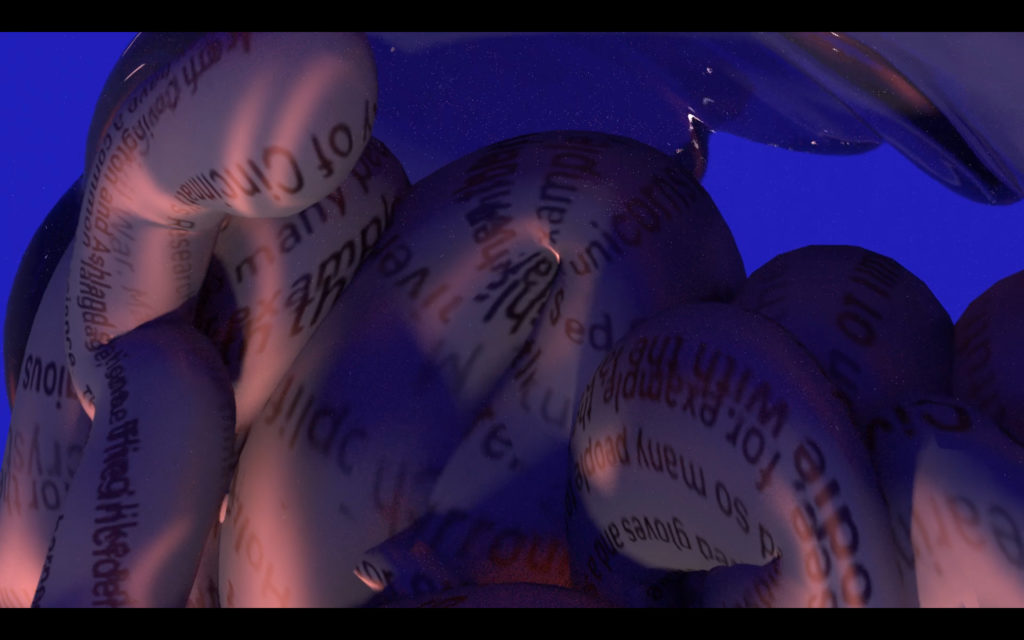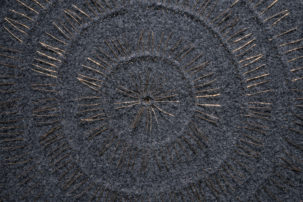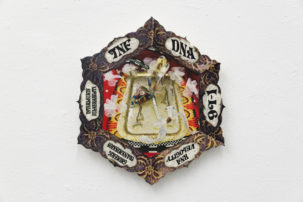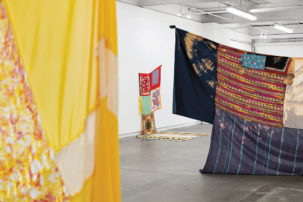Xuan Ye approaches human-machine couplings the way one might any other intimate bond: as a spectrum of need and fulfilment, aspiration and alienation between two amorous agents. Ye’s aesthetic practice doesn’t simply engage digital technologies, but employs them to access deeper realms of desire, dreaming and what constitutes communication. Like language, machines and code are tools that form human experience, feeling and expression—so why can they feel so disembodied and distant?
It feels a little creepy to symbiotically bond with a machine. Ye’s work insinuates that maybe this feeling is fear of losing control despite our interdependencies. Through intentional collaboration with machines, Ye recoups agency. A low-frequency crackling permeated the small room of “The Oral Logic,” part of a generative music score Ye created with collaborator Jason Doell, like ASMR but in a register of minor terror. The score popped and rumbled from two subwoofers, one upturned to hold empty and half-filled clear pill capsules in its speaker. Corrugated air ducts twisted around this installation—collectively titled Garrulous Guts (2019)—as physical stand-ins for its eponymous organs. An accompanying projection animated intestines in cyber blue and dusky pink, mapped with texts from translation theory, which wormed their outsides and innards through the viewer’s gaze.

Xuan Ye, Garrulous Guts (installation detail), 2019. Two-channel animation (5 min), subwoofers, capsules, air ducts, moss and generative music in collaboration with Jason Doell.

Xuan Ye, Deep Aware Triads (The Oral Logic), 2019. Archival ink-jet print, 91.4 cm diameter.

Xuan Ye, Deep Aware Triads (The Oral Logic) (detail), 2019. Archival ink-jet print, 91.4 cm diameter.
Easily recognizable and simplified forms that represent consumption and the body, like the corrugated ducts and pill capsules, were nonetheless incongruous with the comparative complexity of their digital counterparts. Common imagery is again made highly subjective in Ye’s three digitally collaged round wall pieces, Deep Aware Triads (2019), each associated with a different body system. More singular in their objecthood than Ye’s installations, the triads are purer concentrations of visual cyber dreaming. Their layered imagery ranges from dense, abstract textures to flow charts (“I will / will bathe / bathe in / in your / your blood” is the wry path of one of them) and diagrammatic elements like molecules and X-ray scans. The effect is one of excess and improvisation. Ye makes me think about apparatuses: an apparatus for thought, feeling, pain, digestion, sex. When does an apparatus become an organ, and vice versa?
The artist proposes cannibalism—“eating and being eaten”—as a metaphor for the relationships between humans and machines. There is a dark humour, too, in this metaphor of a dialectical mealtime with the other—see Ye’s multimedia installation ERROAR!#4 (2019), which follows the true story of two AI agents eating another AI because they thought it was food, and Cmd & Ctrl Chewing Gum (2019), in which people are encouraged to chew and spit custom-created gum to resist complete annihilation of self against unsolicited external forces. Consuming the other reminds me of the eroticism of Georges Bataille or Suehiro Maruo: eating what you most desire in metaphorical terms (or not). By imagining a complete union of human and machine, the exhibition dreamed of a place of non-alienation—of perfect consumption, like an impossibly perfect desire.

Xuan Ye, ERROAR!#4, 2019. Single-channel video (3 min 25 sec), interactive software, laser-engraved mirror, 3D prints, generative poetry on paper scroll, music in collaboration with Jason Doell.

Xuan Ye, Garrulous Guts (installation view), 2019. Two-channel animation (5 min), subwoofers, capsules, air ducts, moss and generative music in collaboration with Jason Doell.

 Xuan Ye, Garrulous Guts (animation still), 2019. Two-channel animation (5 min), subwoofers, capsules, air ducts, moss and generative music in collaboration with Jason Doell.
Xuan Ye, Garrulous Guts (animation still), 2019. Two-channel animation (5 min), subwoofers, capsules, air ducts, moss and generative music in collaboration with Jason Doell.







